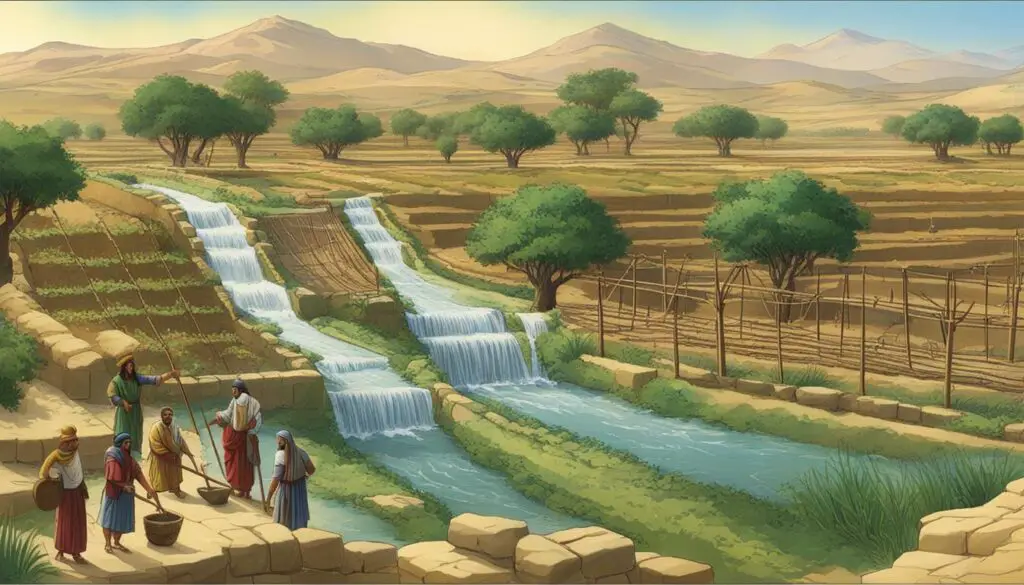
Welcome to the first section of our article on agricultural techniques in biblical lands. In this section, we will provide a historical overview of the ancient farming practices and sustainable agriculture methods employed in biblical times. Through archaeological excavations and interdisciplinary research, experts have gained valuable insights into the crop cultivation and historical crop management in biblical lands. So, let’s dive into the fascinating world of ancient agriculture!
Key Takeaways
- Ancient agriculture in biblical lands provides valuable insights into historical crop management and sustainable agriculture practices.
- Archaeological evidence reveals the cultivation of various crops, including cereals, fruits, and vegetables, during different archaeological periods.
- The Mesolithic, Neolithic, Chalcolithic, and Bronze Age periods mark significant milestones in the development of agricultural techniques.
- Sustainable agriculture principles were followed in biblical lands, including allowing the land to lie fallow and practicing gleaning.
- Terraced farming, irrigation systems, and careful cultivation were essential practices for maintaining fruitful agriculture in biblical lands.
Ancient Farming Practices in Biblical Lands: The Early Periods
The history of agricultural techniques in biblical lands can be traced back to the early periods, including the Mesolithic, Neolithic, and Bronze Ages. During these times, ancient civilizations developed farming practices and utilized various techniques to cultivate crops and manage the land.
Archaeological evidence from these periods provides insights into the types of crops cultivated and the tools used for farming. Flint sickles, mortars, and pestles have been discovered, indicating the cultivation of cereals such as wheat and barley. As settlements grew during the Chalcolithic period, the cultivation of crops expanded to include lentils, olives, dates, and grapes.
The Egyptians, known for their advanced agricultural practices, had a sophisticated irrigation system that allowed them to maximize crop production. Similarly, the Israelites, after gaining possession of the Promised Land, developed their own system of irrigation and employed various farming techniques to ensure the fertility of the land. These ancient civilizations recognized the importance of agricultural practices for sustaining their communities and relied on innovative methods to optimize crop yield.

In summary, the early periods in biblical lands witnessed the development of agricultural techniques that laid the foundation for sustainable farming practices. Through archaeological discoveries, we have gained valuable insights into the types of crops cultivated and the tools used during these eras. The irrigation systems and land management techniques implemented by ancient civilizations like the Egyptians and Israelites demonstrate their understanding of the importance of sustainable agriculture. By studying these ancient farming practices, we can learn from the wisdom of our ancestors to inform our modern approaches to agriculture and land stewardship.
Sustainable Agriculture in Biblical Lands: Principles and Practices
When examining the agricultural practices of biblical lands, it becomes evident that the ancient Israelites were pioneers of sustainable agriculture. These practices, rooted in biblical teachings, encompassed a holistic approach to land management and cultivation.
The Israelites understood that they were caretakers of the land, entrusted with its stewardship. They adhered to traditional farming methods that prioritized the long-term health of the soil and the environment. By following these practices, they ensured the continuity of fertile agricultural lands for generations to come.
One of the key principles of sustainable agriculture in biblical times was the concept of allowing the land to rest every seven years. This practice, known as the sabbatical year, involved letting the fields lie fallow, allowing the soil to rejuvenate and replenish its nutrients naturally. This not only preserved soil fertility but also provided food for the poor, as the land was open for gleaning.
Ancient irrigation systems were another crucial element of sustainable agriculture. The Israelites developed intricate systems for collecting and distributing water, such as terraced farming and cisterns. These methods allowed for efficient water usage, preventing wastage and ensuring the optimal growth of crops.
Overall, the biblical farming techniques employed by the ancient Israelites were a testament to their wisdom and respect for the land. Their sustainable practices, including traditional farming methods, ancient irrigation systems, and thoughtful land management, served as an inspiration for future generations, as they recognized the interconnectedness of agriculture and the environment.
FAQ
What is the significance of studying the history of ancient agriculture in the Land of Israel?
Studying the history of ancient agriculture in the Land of Israel provides valuable insights into the agricultural techniques employed in biblical lands. It helps us understand the development of rural settlements, the crops cultivated, and the technology used in agriculture during different archaeological periods.
What evidence has been gathered through archaeological excavations and surveys?
Archaeological excavations and surveys have provided researchers with data on the development of rural settlements, including villages, hamlets, and farms, as well as their landscapes and the technology used in agriculture. Plant and wood remains found at sites have helped researchers understand the variety of crops and fruit trees cultivated during different archaeological periods.
What interdisciplinary work has contributed to knowledge about ancient agricultural practices?
Interdisciplinary work with geomorphologists, agronomists, and botanists has further contributed to knowledge about ancient agricultural practices. By collaborating with experts in various fields, researchers have been able to gain a deeper understanding of the techniques and practices employed by ancient farmers.
At what point in history did farming activities begin to emerge in biblical lands?
Farming activities began to emerge in biblical lands during the Mesolithic and Neolithic periods. Archaeological evidence such as flint sickles, mortars, and pestles indicate the cultivation of cereals during these periods.
What crops were cultivated during the Chalcolithic period?
During the Chalcolithic period, crops like wheat, barley, lentils, olives, dates, and grapes were cultivated in the biblical lands.
What agricultural practices did the ancient Israelites follow?
The ancient Israelites practiced sustainable agriculture based on principles outlined in the Bible. They followed rules such as allowing the land to lie fallow every seventh year, which allowed for the regeneration of nutrients and the provision of food for the poor. They also practiced gleaning, leaving a portion of the harvest for the less fortunate. Additionally, they employed terraced farming, irrigation systems, and careful cultivation to ensure the fertility of the land.








